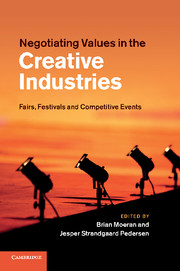Book contents
- Frontmatter
- Contents
- Figures
- Tables
- Contributors
- Acknowledgements
- Introduction
- 1 A Salon’s life
- 2 Art fairs
- 3 Biennalization and its discontents
- 4 Staging auctions
- 5 The book fair as a tournament of values
- 6 Inventing universal television
- 7 Transforming film product identities
- 8 Event institutionalization and maintenance
- 9 Tradition and transformation at the Fan Fair festival
- 10 Between art and commerce
- 11 Configuring sustainability at fashion week
- 12 An inconvenient truce
- 13 The retrospective use of tournament rituals in field configuration
- Afterword Converting values into other values
- Author index
- Subject index
- References
1 - A Salon’s life
field-configuring event, power and contestation in a creative field
Published online by Cambridge University Press: 25 October 2011
- Frontmatter
- Contents
- Figures
- Tables
- Contributors
- Acknowledgements
- Introduction
- 1 A Salon’s life
- 2 Art fairs
- 3 Biennalization and its discontents
- 4 Staging auctions
- 5 The book fair as a tournament of values
- 6 Inventing universal television
- 7 Transforming film product identities
- 8 Event institutionalization and maintenance
- 9 Tradition and transformation at the Fan Fair festival
- 10 Between art and commerce
- 11 Configuring sustainability at fashion week
- 12 An inconvenient truce
- 13 The retrospective use of tournament rituals in field configuration
- Afterword Converting values into other values
- Author index
- Subject index
- References
Summary
Research on field-configuring events (FCEs) is still at an early stage, but existing research suggests that such events as art fairs and biennales, film and music festivals are especially important within creative fields (e.g., Anand and Jones, 2008; Entwistle and Rocamora, 2006; Tang, Chapter 3). This might relate to the regular need to evaluate what should be considered as art, an uncertain and temporary notion, the shared understanding of which is the very basis of any ‘artworld’ (Danto, 1964). Hence, the stakes for participants are high. Galleries, for instance, struggle to obtain a booth at the main art fairs where millions of dollars worth of transactions are made (Thornton, 2008), and art fairs and biennales have risen to such a central position in the art market that they are now an industry in themselves – as the chapters by Don Thompson (Chapter 2) and Jeannine Tang (Chapter 3) in this volume show.
While FCEs are mostly considered as co-ordination mechanisms in the existing literature (Lampel and Meyer, 2008), research also suggests that in creative fields they operate as important mechanisms whereby the dominant group in the field is allowed to wield symbolic power (Anand and Watson, 2004). As such, a central FCE is a typical feature of a centralized field ruled by a dominant group. Referring to Appadurai’s notion of a ‘tournament of value’ (Appadurai, 1986), N. Anand and his co-authors Mary Watson (2004) and Brittany Jones (2008) show that the FCE operates as a ‘tournament of value’ where the dominant view of value is enforced and that of creativity promoted as it rejects competing approaches (Peterson and Anand, 2004). Yet, Brian Moeran and Jesper Strandgaard Pedersen’s notion of a ‘tournament of values’ outlined in the introduction, and developed further by Moeran in his chapter on book fairs (Chapter 5), opens up an alternative perspective to this approach by suggesting that FCEs might be events where dominant values are contested instead of being reinforced. Such a situation can be found in many FCEs where intense discussions, debates and disagreements take place around what should, and what should not, be considered as ‘worthy’, and ‘unworthy’, art, with or without ‘value’.
- Type
- Chapter
- Information
- Negotiating Values in the Creative IndustriesFairs, Festivals and Competitive Events, pp. 36 - 58Publisher: Cambridge University PressPrint publication year: 2011
References
- 8
- Cited by



